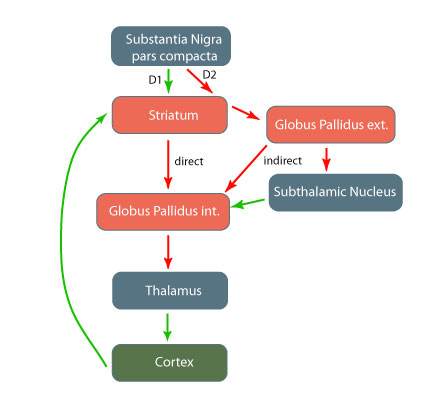
Basal Ganglia
last authored:
last reviewed:
Introduction
The basal ganglia are masses of gray matter deep within the cerebral hemispheres. They are are involved in a number of important loops controlling movement, many of which feed back to inhibit the sensorimotor cortex.
Functions
The basal ganglia can be seen as the principal subcortical components of a family of circuits joining the thalamus and cortex. These circuits are segregated both structurally and functionally, and include the skeletomotor circuit, oculomotor circuit, prefrontal circuits, and limbic circuit.
Role in Cognition and Emotions
The basal ganglia, including the striatum and basal ganglia, are innervated by areas of the prefrontal and limbic cortex. Projections go to the ventral anterior and medial dorsal thalamic nuclei before returning to the dorsolateral prefrontal area.
The prefrontal circuit has been broadly implicated in "executive functions".
The lateral orbitofrontal circuit arises in the lateral prefrontal cortex and projects to the caudate nucleus, traveling through the pallidum and substantia nigra pars reticulata en route back to the orbitofronal cortex via the thalamus. It appears to be involved in mediating empathetic and socially appropriate responses. Damage to it can result in irritability, emotional lability, failure to respond to social cues, and lack of empathy. Obsessive-compulsive disorder is thought to invole the lateral orbitofrontal cortex and circuit.
The anterior cingulate circuit arises in the anterior cingulate gyrus and projects to the ventral striatum, which also receives liombic input from the hippocampus, amygdala, and entorhinal cortices. Again, output goes throught the thalamus as it returns to the cortex. It appears to be important in motivated behaviour and procedural learning.
In general, disorders affecting the basal ganglia can be associated with intensified action (impulsivity) or flattened action (apathy). OCD or mania can be thought of as forms of hyperactivity, and depression can be thought of as a reduced activity.
Schizophrenia might be thought of as a "Parkinson Disease of thought", arising from disorganized modulation of prefrontal circuits. Other cognitive and emotional symptoms might be considered equivalents of motor symptoms such as tremor, dyskinesia, and rigidity.
Structures
The basal ganglia include:
- striatum (input)
- globus pallidus (output)
- substantia nigra
- subthalamic nucleus
The internal capsule runs between the basal ganglia nuclei, giving it a striped appearance and the name striatum.
The Striatum
The striatum which includes the caudate and putamen, is the major site of input to basal ganglia:
- from cortex (glutamate), especially sensorimotor, premotor, and frontal eye fields
- from thalamus
- from the substantia nigra, and raphe nuclei, using 5-HT and DA
The caudate and putamen send inhibitory signals to the globus pallidus and substantia nigra reticula,
- nucleus accumbens
The Globus Pallidus
- Outputs, mainly from globus pallidus interna and substantia nigra reticula, to brainstem, thalamus, and through this, the cortex (motor, premotor, prefrontal)
The globus pallidus interna (GPi) tonically inhibits the ventral nuclei of the thalamus, using GABA-ergic axons.
Substantia Nigra
The substantia nigra is a group of neurons located in the posterior midbrain. The substantia nigra's most prominent porjections are to the striatum.
The pars compacta neurons are dopamine-producing. The pars compacta is continuous with the ventral tegmental area, which also is dopaminergic.
The pars reticula uses GABA.
The substantia nigra appears at least in part to be involved in initiation of voluntary movement.
Degeneration of dopamine-producing neurons in the substantia nigra is associated with Parkinson's Disease.
Subthalamic Nucleus
The subthalamus lies between the dorsal thalamus and tegmentum of the midbrain.
It is involved in sensory, motor, and reticular function.
The subthalamic nuclei recieves fibres from the globus pallidus and in turn sends excitatory glutaminergic fibres back to it.
Problems with the subthalamus can result in hemiballismus.

Outputs
The two output nuclei of the basal ganglia are the globus pallidus interna and the substantia nigra reticulata. Both fire at tonically high rates, inhibiting the thalamus and thereby the cortex and movement.
Direct pathway (positive feedback)
- facilitates movement via activation of D1 receptors
- phasic activation decreases GPi output, allowing thalamic and cortical signaling and facilitating movement
Indirect Pathway
- phasic activation increases inhibition of thalamus
- via D2 receptors
The basal ganglia have an indirect output to the spinal cord through the red nucleus in the midbrain, which sends out the rubrospinal tract.
Conditions Affecting the Basal Ganglia
Due to their role in inhibitory feedback loops, many disorders affecting the basal ganglia involve abnormal movements that can be repetitive or rhythmic as a result of abnormal electrical oscillations.
Tremor and other involuntary movements, changes in muscle tone and posture, and slowness of movement without paralysis are all common indisorders affecting the basal ganglia.
Overactivity of the indirect pathway is an important contributor to Parkinsonian signs.
- tremor or other involuntary movements
- changes in posture and tone
- too much movement
- NOT paralysis
Underactivity in the indirect pathway can result in hyperkinetic disorders
Patients with Huntington's and Parkinson's disease have changes in affect, behaviour, emotion, and cognition.
